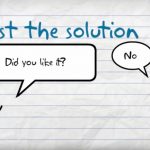In Design Thinking it is always important to question one’s own point of view or even to adopt other points of view when solving a problem. The Point of View is the third phase in our Design Thinking process and describes the area in which we want to align and define our point of view. How do we understand what we are observing or what did we actually observe? At the end of this phase we want to continue with a problem definition or problem statement into the fourth phase, the Ideate or Idea Generation.
The Point of View
As I said before, we come from observation, the Observe in our design thinking process. So what we have now, ahead of us are quite a lot of statements, interview transcripts, data, opinions or results of our observations. These we have to arrange and define our point of view. Of course, I can approach this in a very practical way.

The point of view in the truest sense of the word
Ideally, I can conduct my Design Thinking activity at a designated location. Maybe a room that I have at my disposal. So I start to decorate the walls with my results. Hang up everything I’ve already created and collected. This helps us not only for the following steps but also directly creates a little order and brings us to our point of view. Now that everything is hanging on the wall, find a place where you can place yourself and look at what you have. Your point of view now comes from the observation. What do we have on the wall and how must I understand that?
Everything that comes to my mind now and is suitable for further processing I write again on cards and hang them up on a designated place. I define my point of view and how to understand the collected data. Mine
Point of View
But it can also go much further. Become creative and take new points of view. Give yourself a role and think about what the Point of View would look like from this person.
Experts and Superheroes
Here you can also get very creative now, how would special characters look at this problem? What would superheroes say? How do they interpret the facts? There are no limits to creativity here.

Finally we define our Problem Statement
At the end of this phase we develop the problem definition or problem statement. After looking at different points of view and collecting some thoughts, we should be able to get a pretty good and neutral view of the problem. So let’s start with the definition of what the problem is. Most of the time this is not visible from the beginning but after a successful Point of View phase you will see that you are in the position to make a statement. How this looks like I already described in another article and will link here again.
Now that you have a good statement you can start generating ideas and solutions. The Ideate Phase, the fourth step in Design Thinking.


